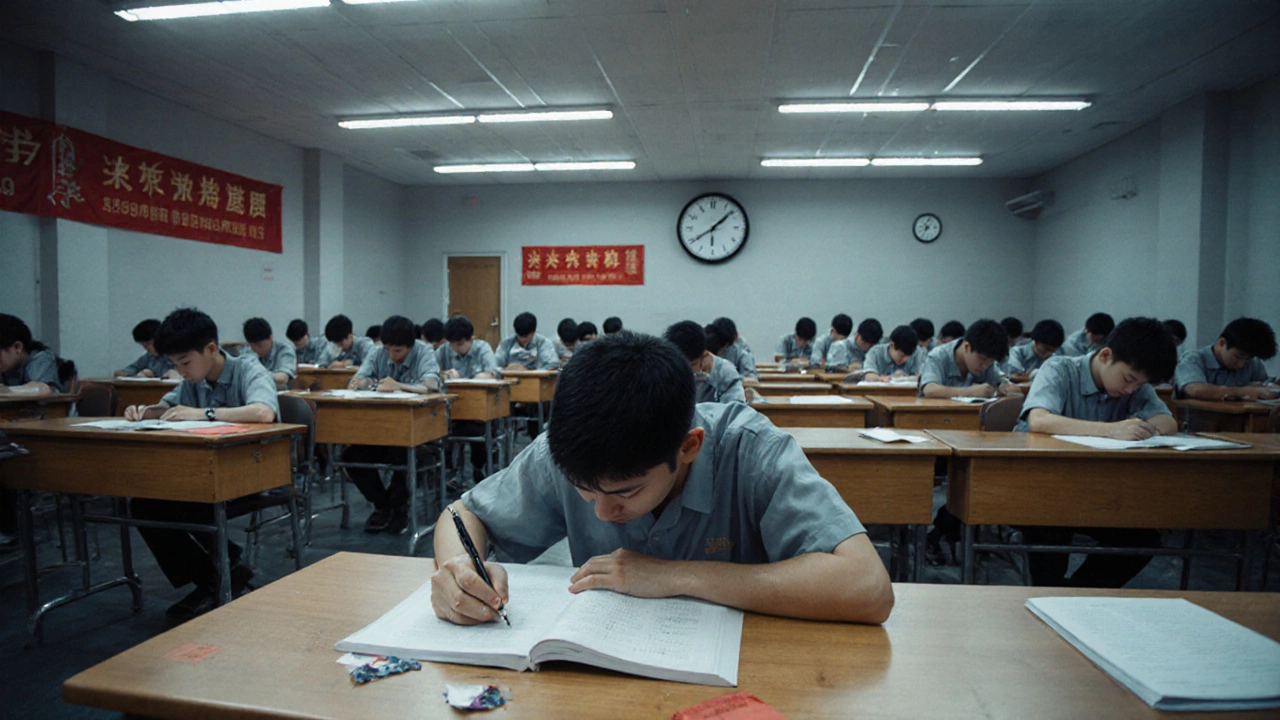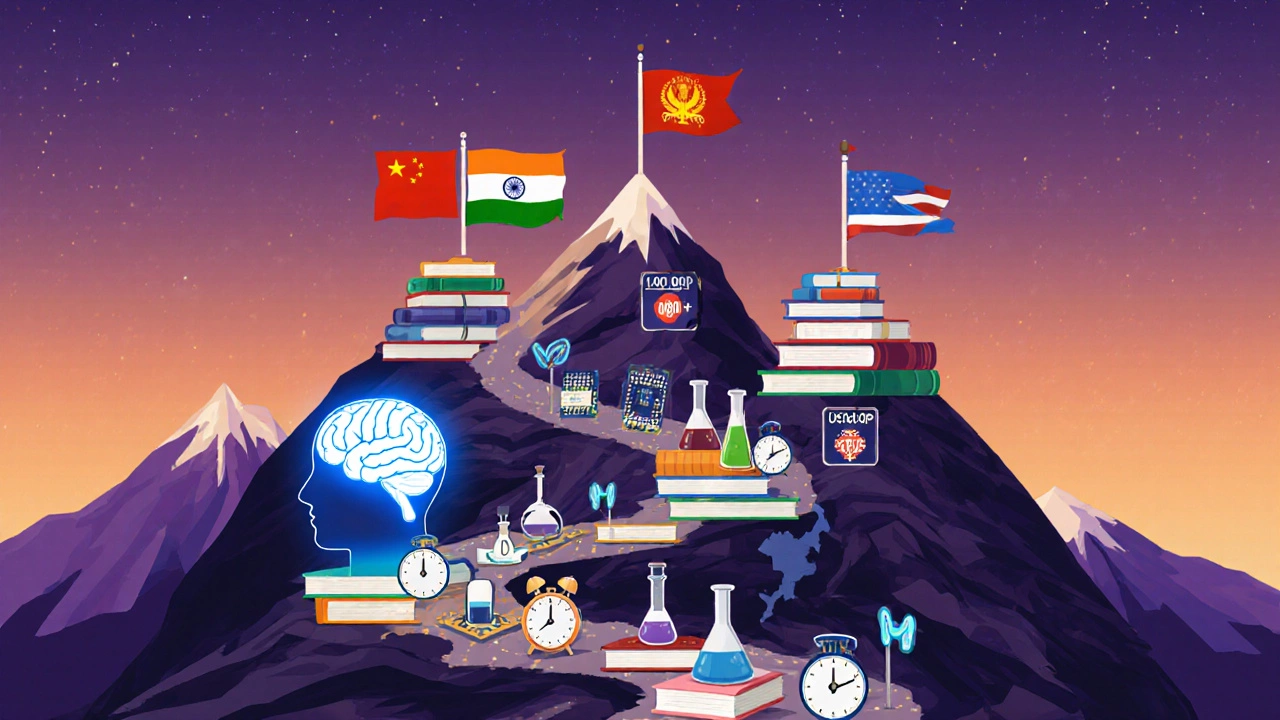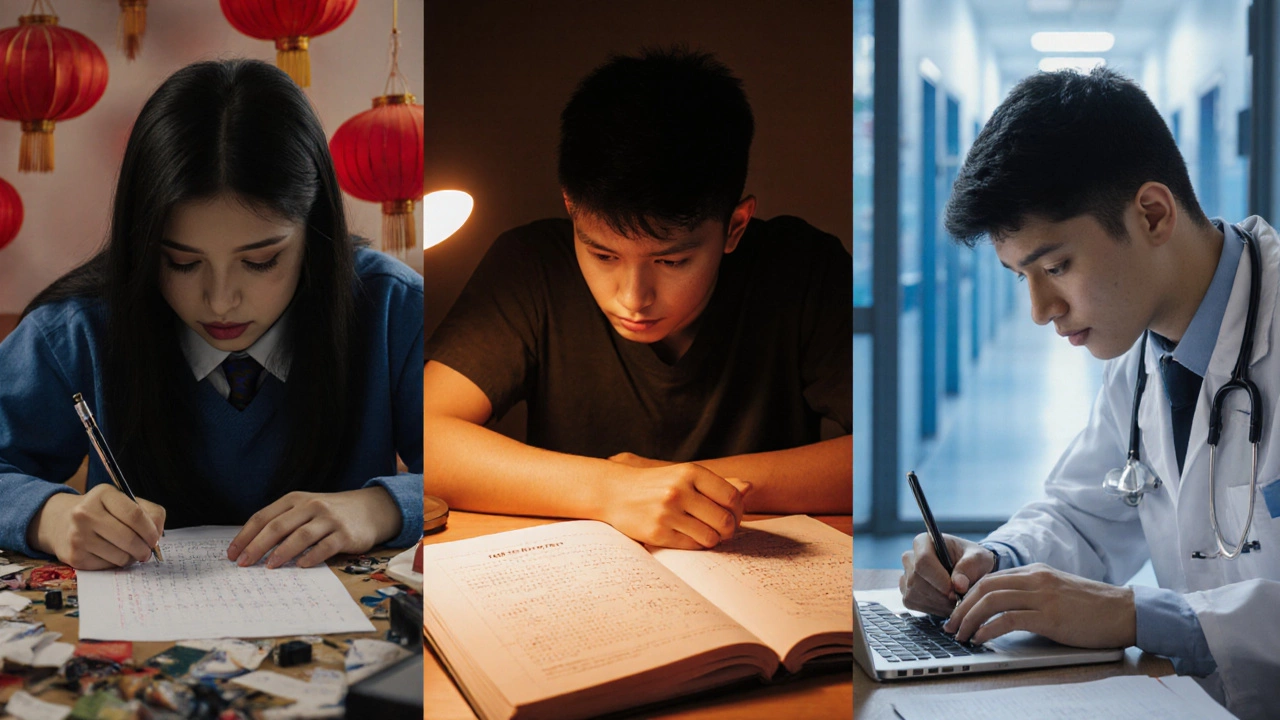Exam Preparation Time Calculator
Choose Your Exam
Key Takeaways
- China's Gaokao, India's IIT JEE Advanced is a marathon for engineering hopefuls, and the U.S. USMLE Step 1 is the gatekeeper for medical licensure, consistently rank among the toughest exams on the planet.
- All three demand 10,000+ study hours, near‑perfect scores for admission, and a pass rate below 20%.
- Preparation strategies focus on early start, systematic syllabus coverage, and high‑intensity mock testing.
- Understanding each exam’s structure helps candidates allocate time and avoid common pitfalls.
How We Chose the "Toughest" Trio
Before naming the three, we set clear criteria so the list isn’t just opinion‑based:
- Pass‑rate pressure: Exams where fewer than one‑in‑five candidates succeed.
- Study‑hour intensity: Official or surveyed data showing candidates invest 10,000+ hours on average.
- Scope & breadth: Content that spans multiple disciplines and requires deep analytical thinking.
- Global impact: Results that determine entry to elite universities or professional licensure worldwide.
Only three exams tick every box.
1. China’s Gaokao - The Ultimate College Entrance Test
The Gaokao (National College Entrance Examination) is a two‑day, 750‑point exam taken by over 10 million high‑school seniors each June. Its stakes are massive: a single score decides whether a student can attend a top‑tier university like Tsinghua or Peking, or be relegated to vocational tracks.
Why it’s brutally hard:
- Volume: Candidates answer around 150 questions covering Chinese literature, mathematics, English, physics, chemistry, and biology.
- Competition: With a national acceptance rate of roughly 5% for elite institutions, every point counts.
- Preparation time: Surveys of top performers report 12,000‑14,000 study hours over three years.
Success stories often involve daily grueling schedules, weekend tutoring, and mock exams that mimic the exact time pressure of the real test.
2. India’s IIT JEE Advanced - Engineering’s Ultimate Gatekeeper
The IIT JEE Advanced follows the preliminary JEE Main and filters the top 2‑3% of engineering aspirants for admission to the Indian Institutes of Technology (IITs). Only about 250,000 candidates sit for the exam each year, but fewer than 15,000 seats are available.
What makes it a nightmare:
- Depth of concepts: Questions require not just textbook knowledge but creative problem‑solving in physics, chemistry, and mathematics.
- Time crunch: Two papers, each lasting three hours, with 90 questions that demand rapid, accurate computation.
- Study input: Top rankers often tally 10,000‑11,000 hours of focused practice, including specialized coaching centers.
Many candidates join elite coaching camps where daily schedules mimic the exam’s pace, incorporating timed drills and detailed solution analysis.

3. United States’ USMLE Step 1 - The Medical Licensing Litmus Test
The USMLE (United States Medical Licensing Examination) Step 1 is taken after the second year of medical school and assesses a student’s mastery of basic sciences. Scoring below 220 (the passing threshold) can jeopardize residency placement.
Why it’s consistently labeled one of the hardest:
- Content breadth: Covers anatomy, biochemistry, physiology, pathology, pharmacology, and microbiology-over 1,500 concepts.
- High stakes: Residency programs rank applicants heavily based on Step 1 scores; a low score can close doors to competitive specialties.
- Study load: Average candidates report 10,000‑12,000 study hours spread across multiple months of intensive review.
Successful test‑takers often use spaced‑repetition platforms, full‑length practice exams, and dedicated question banks to simulate the exam’s format.
Side‑by‑Side Comparison
Key Metrics of the Three Toughest Exams
Exam
Country / Region
Typical Candidates per Year
Pass Rate
Average Study Hours
Main Subject Areas
Gaokao
China
~10,000,000
~20% for elite universities
12,000‑14,000
Chinese, Math, English, Science
IIT JEE Advanced
India
~250,000
≈6% overall
10,000‑11,000
Physics, Chemistry, Mathematics
USMLE Step 1
United States
~20,000 (US medical schools)
≈92% (pass), but score thresholds for residency are high
10,000‑12,000
Basic Sciences (Anatomy, Physiology, etc.)
Preparation Playbook for Each Exam
Even though the exams differ in subject matter, the winning formula shares common steps.
- Start Early: Begin structured study at least two years before the exam (Gaokao) or one year for the other two.
- Build a solid foundation before tackling advanced problems.
- Map the Syllabus: Use the official syllabus as a checklist. Mark each topic as "not started," "in progress," or "mastered."
- This works for the Gaokao’s 12‑subject spread and the USMLE’s 1,500‑concept list.
- High‑Intensity Practice: Simulate exam conditions with timed mock papers.
- For JEE Advanced, aim for at least three full‑length papers per month.
- USMLE aspirants should complete at least 8 full practice exams before the real test.
- Analyze Errors: After each mock, categorize mistakes (knowledge gap vs. careless error) and revisit those topics.
- Health Management: Sleep 7‑8hours, short breaks every 90minutes, and regular exercise keep cognitive stamina high.

Common Pitfalls and How to Dodge Them
Knowing where most candidates trip helps you stay ahead.
- Relying on rote memorization: Especially fatal for JEE Advanced, where application beats recall.
- Ignoring weak areas: One low‑scoring topic can drop an overall Gaokao score below the elite cut‑off.
- Skipping full‑length mocks: USMLE candidates who only study individual questions miss the stamina test.
- Burnout: Pushing 12‑hour study marathons without breaks leads to diminishing returns.
Implement a weekly review schedule, keep a mistake log, and schedule at least one “rest day” per week.
What Success Looks Like
Beyond the scores, the three exams shape career trajectories.
- Gaokao top‑rankers often secure spots at China’s premier universities, leading to careers in research, finance, or government.
- IIT JEE Advanced qualifiers join elite engineering programs, opening doors to high‑tech firms and postgraduate scholarships worldwide.
- USMLE Step 1 high‑scorers gain access to competitive residency matches in specialties like surgery, dermatology, or radiology.
The common thread? Discipline, strategic planning, and relentless practice.
Frequently Asked Questions
Is the Gaokao really harder than the SAT?
Yes. While the SAT tests basic reading and math skills, the Gaokao covers six subjects in depth, lasts two full days, and determines university placement for millions of students, making its pressure and content breadth far greater.
How many hours should I study for JEE Advanced?
Top performers report between 10,000 and 11,000 dedicated study hours spread over 18‑24 months, averaging 15‑20 hours per day during peak months.
Can an international student take the USMLE Step 1?
Yes. Any graduate of a medical school meeting the ECFMG (Educational Commission for Foreign Medical Graduates) criteria can sit for Step 1, provided they have a valid USMLE eligibility ID.
What is the best way to track my progress for these exams?
Create a spreadsheet with columns for topic, study hours, mock score, and error type. Update it after each study session and mock exam to spot trends quickly.
Are there scholarships tied to high scores on these exams?
Many universities in China and India award merit‑based scholarships to top Gaokao and JEE ranks. In the U.S., high USMLE scores can boost eligibility for competitive residency grants and research fellowships.
| Exam | Country / Region | Typical Candidates per Year | Pass Rate | Average Study Hours | Main Subject Areas |
|---|---|---|---|---|---|
| Gaokao | China | ~10,000,000 | ~20% for elite universities | 12,000‑14,000 | Chinese, Math, English, Science |
| IIT JEE Advanced | India | ~250,000 | ≈6% overall | 10,000‑11,000 | Physics, Chemistry, Mathematics |
| USMLE Step 1 | United States | ~20,000 (US medical schools) | ≈92% (pass), but score thresholds for residency are high | 10,000‑12,000 | Basic Sciences (Anatomy, Physiology, etc.) |
- Build a solid foundation before tackling advanced problems.
- This works for the Gaokao’s 12‑subject spread and the USMLE’s 1,500‑concept list.
- For JEE Advanced, aim for at least three full‑length papers per month.
- USMLE aspirants should complete at least 8 full practice exams before the real test.
Frequently Asked Questions
Is the Gaokao really harder than the SAT?
Yes. While the SAT tests basic reading and math skills, the Gaokao covers six subjects in depth, lasts two full days, and determines university placement for millions of students, making its pressure and content breadth far greater.
How many hours should I study for JEE Advanced?
Top performers report between 10,000 and 11,000 dedicated study hours spread over 18‑24 months, averaging 15‑20 hours per day during peak months.
Can an international student take the USMLE Step 1?
Yes. Any graduate of a medical school meeting the ECFMG (Educational Commission for Foreign Medical Graduates) criteria can sit for Step 1, provided they have a valid USMLE eligibility ID.
What is the best way to track my progress for these exams?
Create a spreadsheet with columns for topic, study hours, mock score, and error type. Update it after each study session and mock exam to spot trends quickly.
Are there scholarships tied to high scores on these exams?
Many universities in China and India award merit‑based scholarships to top Gaokao and JEE ranks. In the U.S., high USMLE scores can boost eligibility for competitive residency grants and research fellowships.

